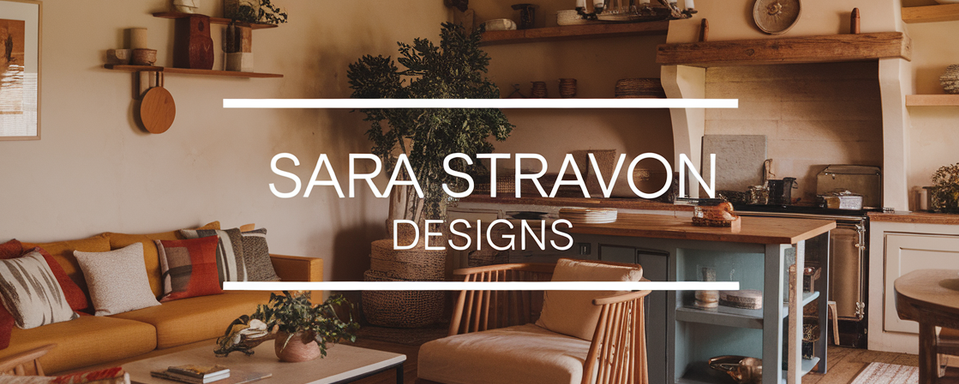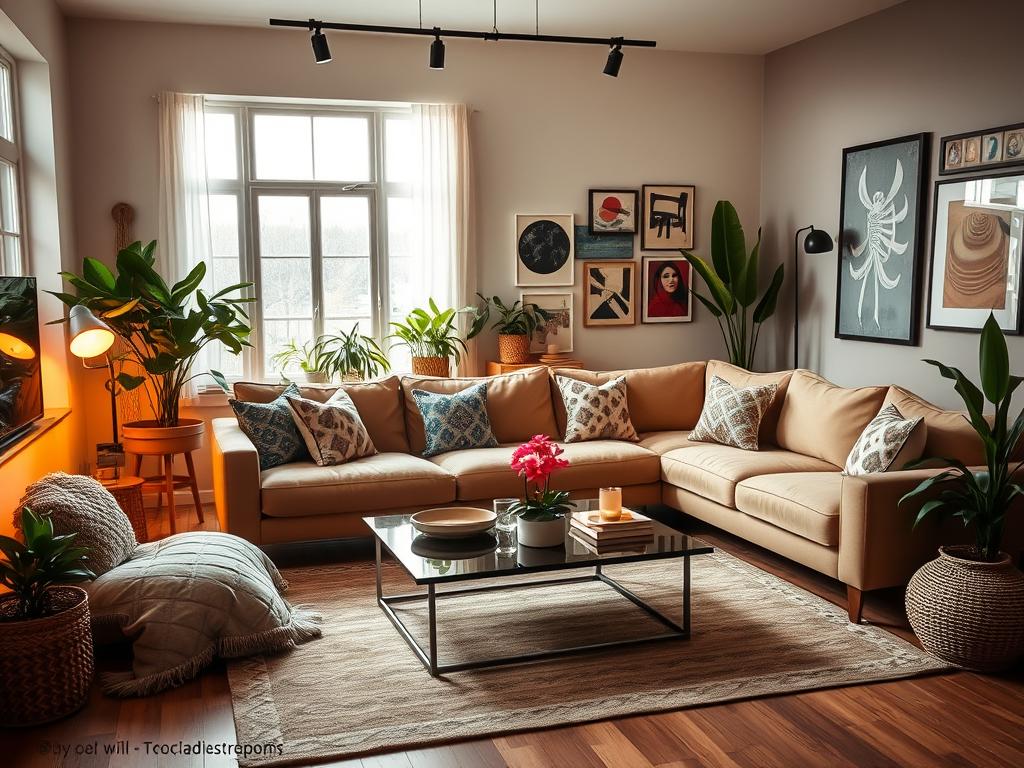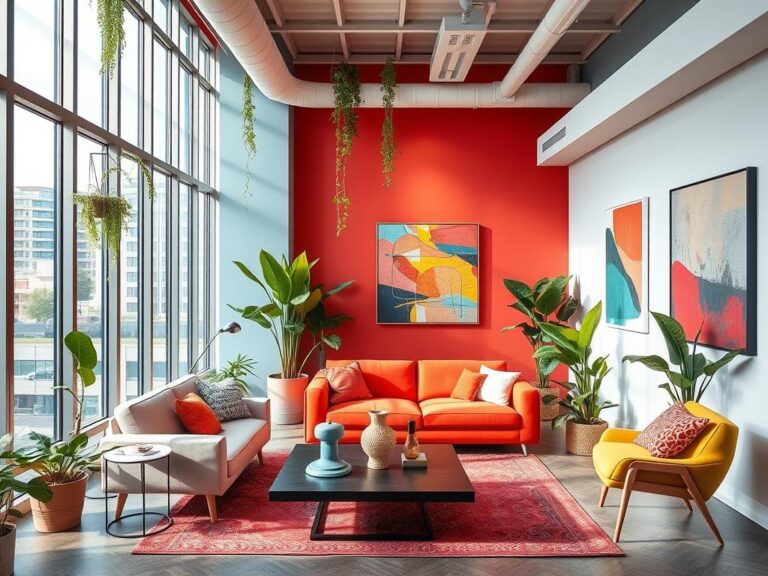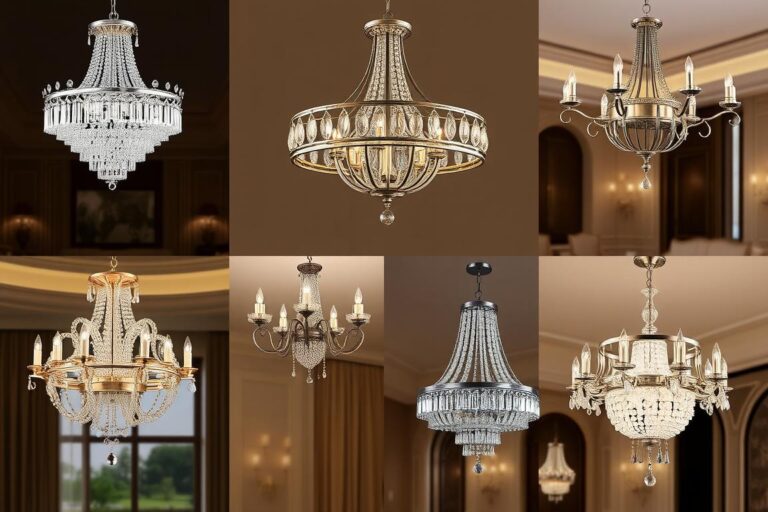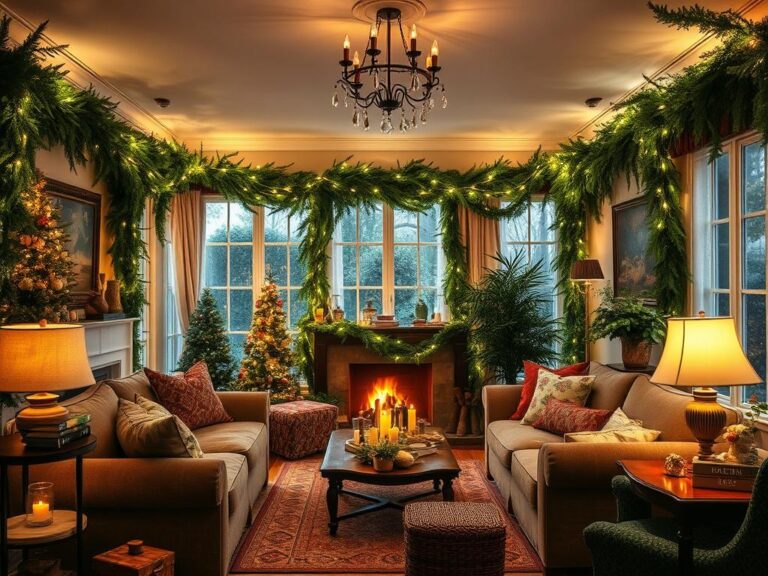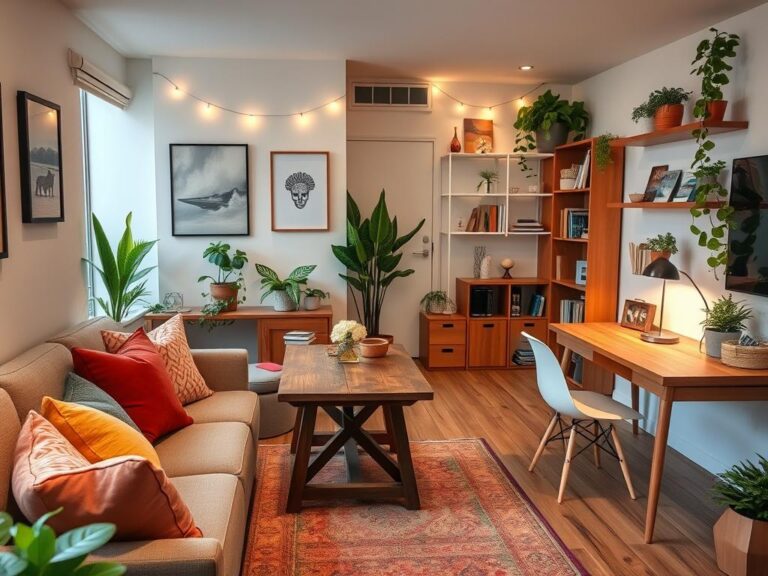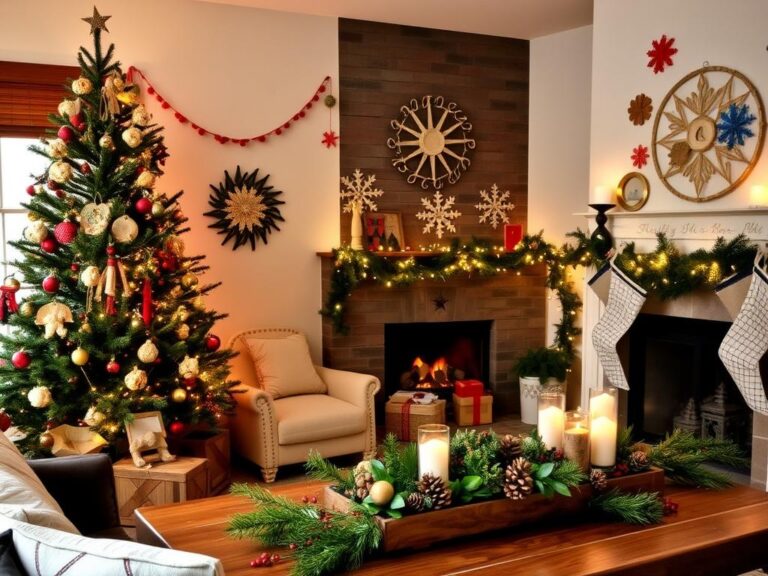Your living room is the heart of your home, where family comes together and memories are made. Making this space cozy and stylish is key. With new decorating ideas and interior design, you can turn your living room into a welcoming place.
Start by understanding your living room’s space and your style. This helps your design match your lifestyle and creates a cozy feel. Whether you like simple designs or a mix of textures, aim for a space that feels warm and inviting.
Explore inspiring decor concepts, from standout furniture to the power of color. With the right touches, your living room will be a cozy, stylish, and functional haven. It will become a special place in your home.
Things To Consider
- The living room is a central gathering space, making its design critical for comfort and style.
- Mixing textures and adding personal touches can make the space feel welcoming and unique.
- Thoughtful artwork placement shows off your living room’s personality.
- Keeping negative space clean helps achieve a clutter-free design.
- Custom lighting greatly affects your living room’s mood.
- Combining different styles creates a personalized yet cohesive look.
- Arranging furniture to let in natural light can make the space feel bigger.
Make Sure You Understand Your Living Room’s Potential
To unlock your living room’s full potential, start with a careful look at your space. Measure the room and note any special features. A good layout makes your space cozy and fits your lifestyle.
Assessing Your Available Space
First, measure your room and note any special features like windows and built-ins. Open-plan layouts are popular for entertaining, with 60% of people preferring them. If your room is big enough, think about how it can improve your living area’s flow and function.
Identifying Your Style Preferences
Your style choices are key in designing your space. Whether you like modern minimalism or traditional looks, add elements that show your personality. Mixing style with comfort makes your space welcoming and enjoyable.
Setting a Realistic Budget
Planning your budget is essential. Furnishing a living room can cost between $3,000 to $10,000. Knowing your budget helps you choose quality furniture that makes your space both cozy and functional.
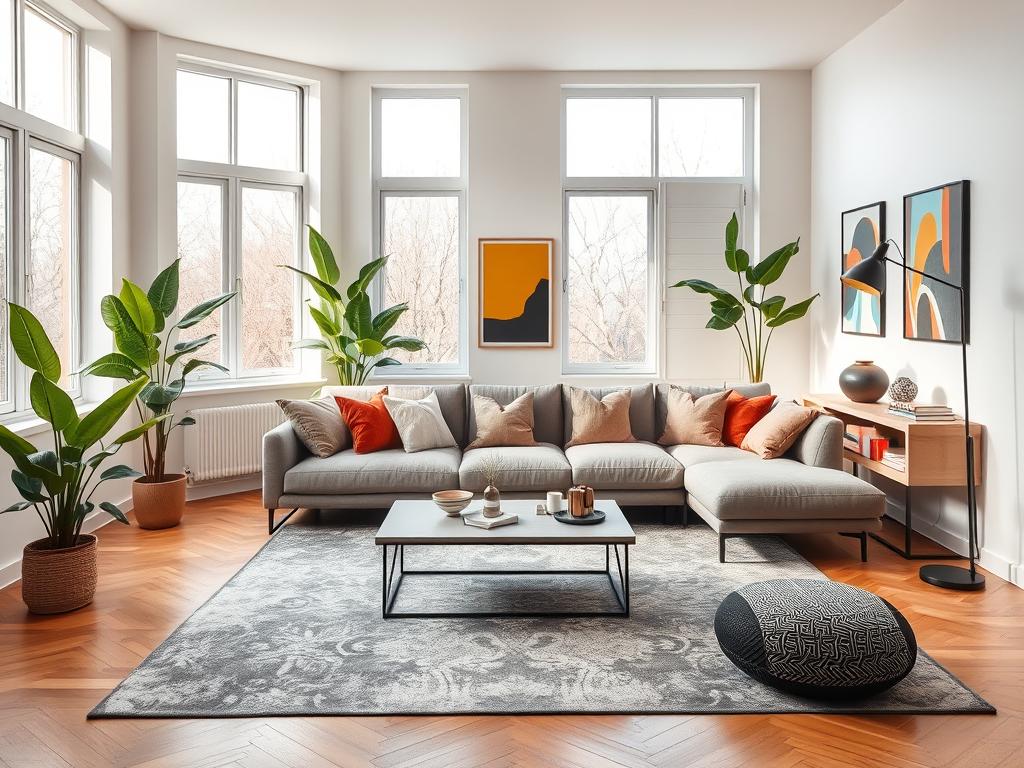
The Psychology of Color in Living Spaces
Color greatly affects your living room’s mood. Knowing how colors make us feel helps pick the right ones. Warm colors like reds and oranges make us feel energetic and happy. They’re perfect for parties.
Cool colors, such as blues and greens, calm us down. They help us relax and feel peaceful. This makes them great for a cozy night in.
Reds are linked to love and passion. They make a room lively, perfect for fun times. But too much red can feel overwhelming.
Yellow makes us feel cheerful and helps us talk more. But too much yellow can make us anxious. Using these colors wisely can make our gatherings more enjoyable.
Green brings balance and calm, great for unwinding. Blue helps us relax and sleep better. It’s calming and can even lower our heart rate.
Purple sparks creativity and self-awareness. It adds a touch of imagination to your living room. Using it in lighter shades can make your space feel more vibrant.
Choosing colors wisely makes your living area more comfortable and uplifting. Accent colors like reds and yellows add energy. But remember, too much can be too much.
Try out your color choices under different lights. This ensures they look good together. Your personal touch in color choice shows off your unique style.
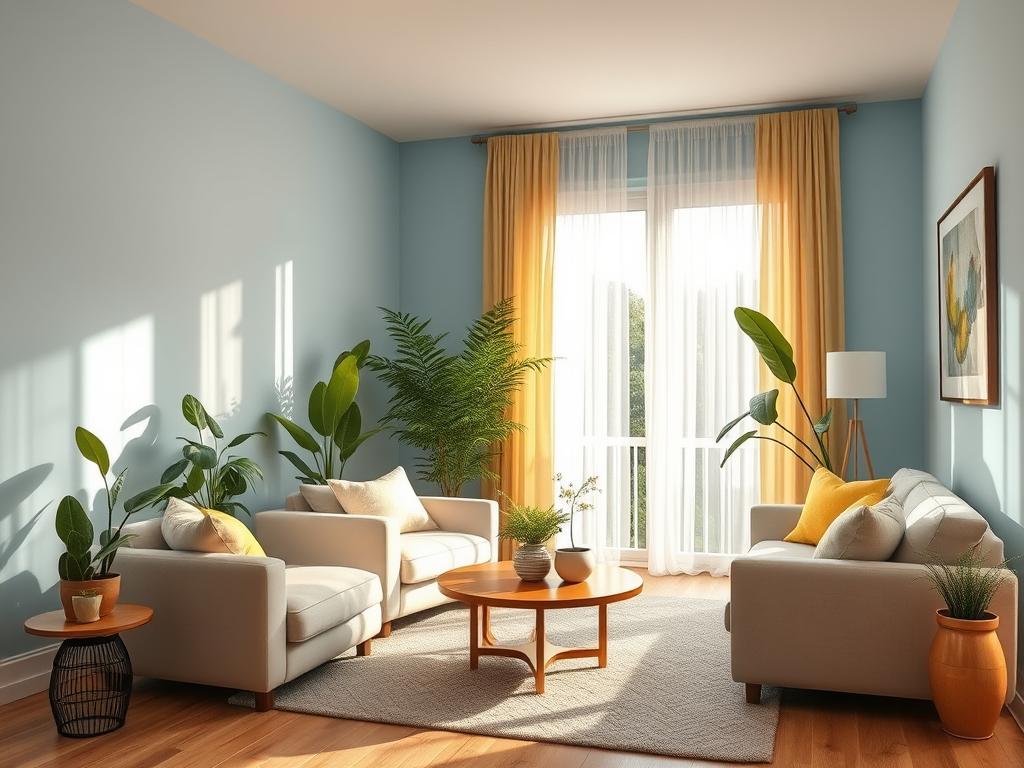
Fundamental Living Room Layout Principles
Creating a great living room design starts with key layout principles. Your furniture should help traffic flow well and make the space useful. By setting up focal points and balancing design, you create a welcoming space for both relaxation and socializing.
Traffic Flow Optimization
Good traffic flow means easy movement in your living room. Make sure there’s 30 to 36 inches of space between big furniture pieces. In smaller areas, use 18 to 24 inches. This makes moving around the room smooth and enjoyable.
Focal Point Creation
A clear focal point is essential in your living room design. It could be eye-catching artwork, a standout piece of furniture, or a fireplace. This focal point ties your decor together and sets the room’s mood. Pull sofas away from walls by 3 to 5 inches to improve looks and interaction with your focal points.
Balance and Symmetry
Balance in design brings harmony to your living room. Use the golden ratio for furniture and rug sizes, aiming for a 2:3 ratio. Place the coffee table half the length of the sofa for scale. Side tables should be 2 to 3 inches below the sofa’s arm for easy reach.
Area rugs should be at least 8×10 feet(depening on size of the room) to fit under the sofa and chairs. This keeps the room open and clutter-free. For more on improving your living room layout, check out this resource.
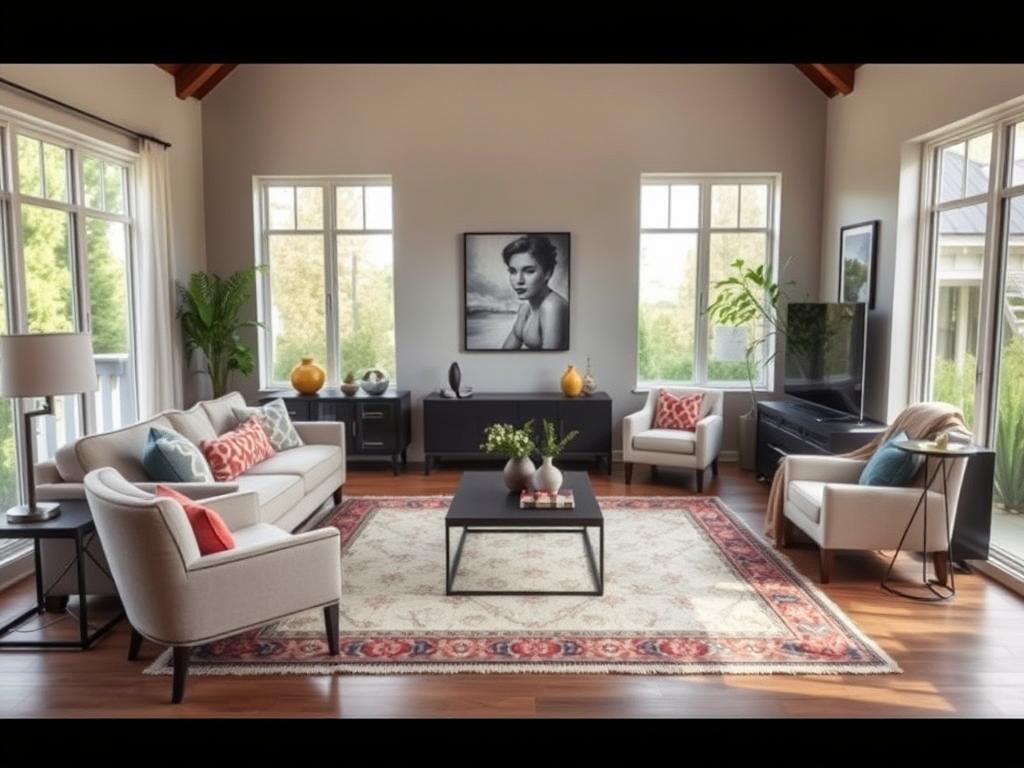
| Furniture Item | Recommended Dimensions |
|---|---|
| Walkway Space | 30″ to 36″; 18″ to 24″ (limited spaces) |
| Seating Distance | 3.5′ to 10′ |
| Sofa Placement | 3″ to 5″ from the wall |
| Coffee Table | Half the length of the sofa |
| Coffee Table Height | 4″ lower or no higher than sofa seat cushions |
| Distance to Coffee Table | 16″ to 18″ |
| Rug Size | At least 8’x10′ |
| Distance from Wall to Rug | 24″ (larger rooms); 10″ to 18″ (smaller rooms) |
| Floor Lamp Height | Approximately 68″ |
Selecting Statement Furniture Pieces
Statement furniture can make your living room look amazing. It turns it into a stylish retreat. Most homeowners, 78%, say these pieces make their homes look better.
Choose furniture that stands out, like a bold sofa or a unique coffee table. These pieces should be both functional and stylish.
Comfort is just as important as looks. 62% of people think comfort is as important as design. Buying quality furniture makes your home look better and increases its value by up to 15%.
Adding unique pieces gives your home character. Interior designers say 82% of bold furniture makes gatherings more interesting. Homes with statement furniture sell 12% faster, showing their appeal.
Make sure your furniture fits with your home’s style. 55% of homeowners say matching elements improve the look. Also, 70% of homeowners see the big impact of statement furniture on a room’s look.
It’s key to balance bold designs with colors that match. 85% of designers say this creates a balanced look.
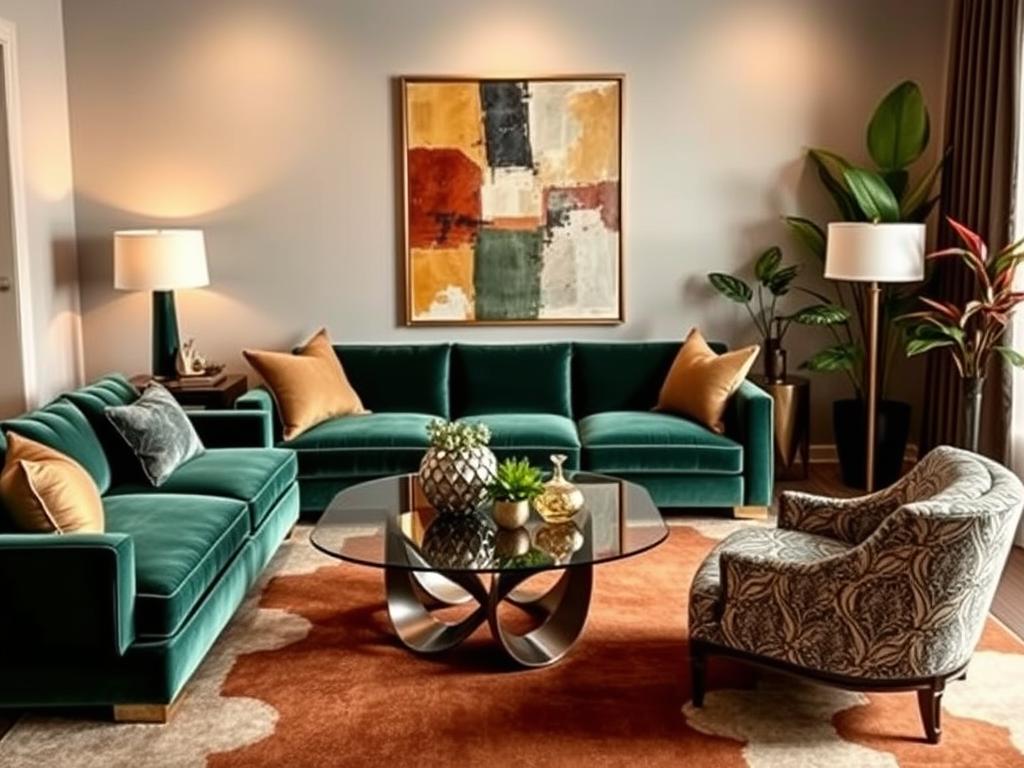
Modern Living Room Design Trends
Keeping up with modern living room design trends can make your home lively and stylish. Using contemporary materials and new ideas can make your space both useful and beautiful.
Contemporary Material Choices
Today’s living rooms use a mix of materials that focus on comfort and style. You’ll see more:
- Reclaimed wood and brushed stone, adding warmth and lasting appeal.
- Natural textures, making the room cozy.
- Eco-friendly choices like bamboo and recycled metals, showing care for the planet.
Popular Style Combinations
Mixing styles is a big part of modern living room decor. The trend includes:
- A shift from minimalism to maximalism, with bright colors and bold wallpapers.
- Art Deco touches, adding richness and unique patterns.
- More vintage pieces, bringing character to modern rooms.
Emerging Design Elements
New design elements are bringing fresh ideas to your living space. Key trends are:
- Statement lighting, set to be 70% of designs soon.
- Curved furniture, making spaces softer and more welcoming.
- Layered lighting and personalized art, showing off your style and comfort.
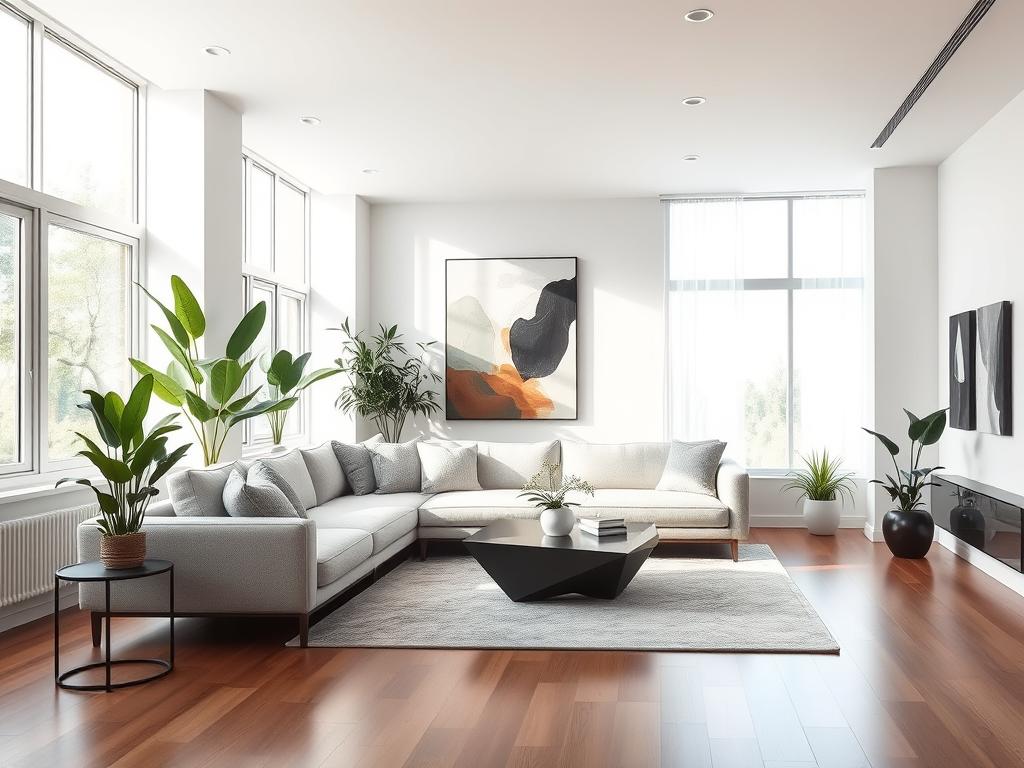
Lighting Strategies for Ambiance
Lighting greatly affects your living room’s feel. Studies show that 75% of people feel better when the lighting is right. By mixing ambient, task, and accent lighting, you can make your space perfect for both relaxing and having fun.
Using lighting fixtures like chandeliers, floor lamps, and wall sconces adds beauty and improves mood. Homes with layered lighting feel 60% more welcoming. This makes them more fun for you and your guests.
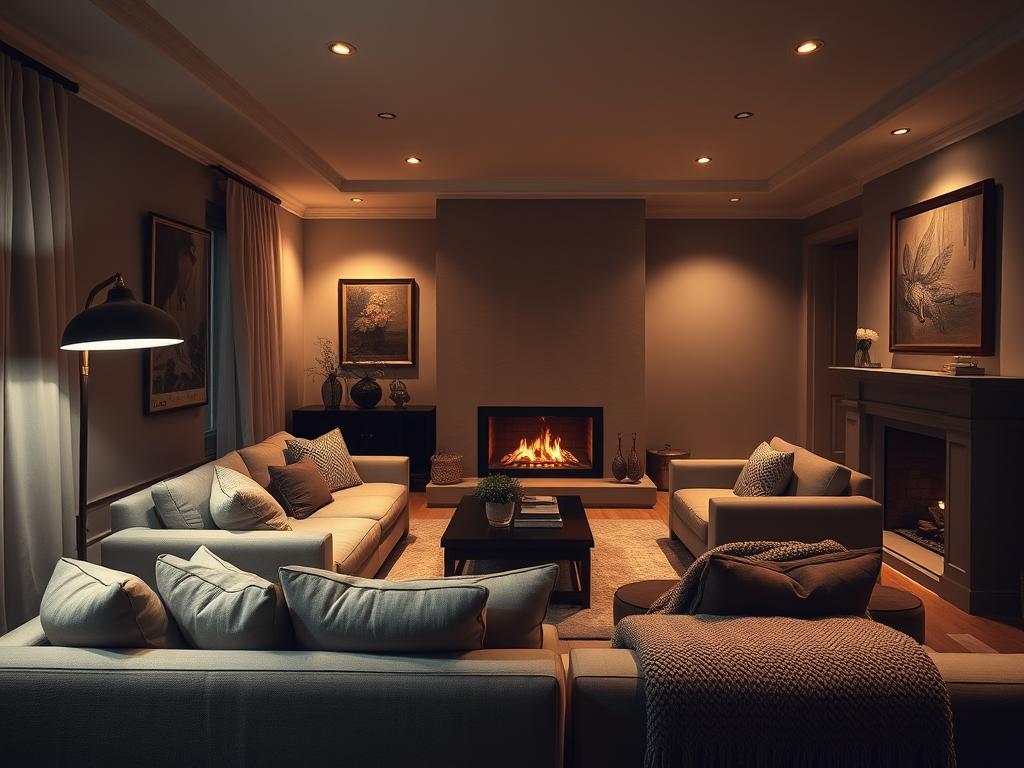
- Combine natural and artificial light to make your room look 25% bigger. This boosts the ambiance.
- Dimmer switches are popular among 45% of homeowners. They let you change the light level for any event.
- Choose warm-toned bulbs, liked by 80% of people. They make your space feel cozy.
- Place task lighting in reading areas to increase productivity by 23% and make the space more useful.
- Accent lighting draws attention to art. It can make art up to 50% more visible, making it a key part of your decor.
Getting the right mix of lighting makes your home inviting. Dimmable lights can go from bright to soft, ideal for unwinding. Homes with great lighting sell for 15% more. This shows the importance of good lighting in your living room.
Textiles and Textures That Transform
Adding different textures to your living room makes it feel warm and inviting. Rugs, curtains, and soft furnishings can really make a difference. They add comfort and help set the mood and function of your space.
Rug Selection and Placement
Choosing the right rug is key to tying your furniture together and matching your colors. Pick rugs that fit your style and help arrange your seating. The right rug placement improves flow and adds warmth.
Textured rugs add depth to your decor. The rug’s material, size, and texture can change the room’s feel a lot.
Curtain and Drape Options
Curtains do more than just block light; they add elegance. Sheer curtains can make your room brighter by up to 50%. Using different fabrics adds depth and versatility.
The colors and patterns of your curtains set the mood. They’re a key part of your decor strategy.
Throw Pillows and Soft Furnishings
Throw pillows and blankets make your space more comfortable. They’re easy to change up and add interest. Mixing textures like velvet or silk makes your room feel cozy.
Using soft materials can make your living room feel 30% more comfortable. It creates a peaceful spot for relaxation.
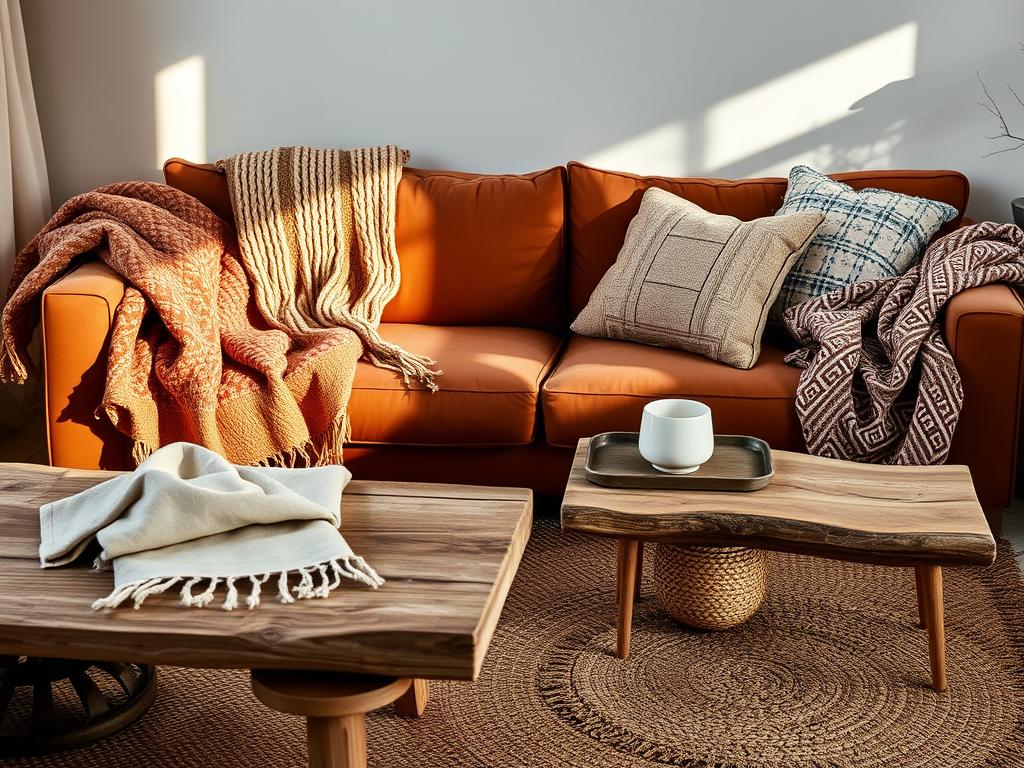
| Textile Element | Functionality | Impact on Mood | Textural Benefits |
|---|---|---|---|
| Rugs | Defines space & enhances flow | +25% inviting quality | Warmth & noise absorption |
| Curtains | Light control & privacy | +50% natural light diffusion | Visual softness & texture |
| Throw Pillows | Adds comfort & style | +30% perceived comfort | Layered designs for depth |
By carefully choosing these textiles, you make your living room cozy and welcoming. The right textures not only improve your style but also create a special connection to your home.
Art and Wall Decor Placement
Art and wall decor are key to showing off your style and adding to your living room’s vibe. Choose artwork that speaks to you, like abstracts, landscapes, or family photos. Make sure the size and style of each piece fit well with the room’s design.
Place art at eye level to draw attention and achieve balance. You can use a gallery wall or a single large piece as a focal point. For example, a grid layout lets you mix different pieces, while a diptych frames a spot nicely. Here are some popular ways to arrange art:
| Configuration | Details |
|---|---|
| Gallery Wall | Includes multiple smaller pieces, typically 3 or more, spaced 2 to 3 inches apart for a cohesive look. |
| Single Large Piece | An eye-catching focal piece that fills a significant wall area, often placed above a sofa or mantel. |
| Diptych | Two pieces that complement each other, often hung side by side for a unified appearance. |
| Mixed Media | Combination of various styles and mediums, such as paintings, mirrors, and 3D elements like clocks or sculptures. |
Vary the types and orientations of your art to keep things interesting. Using the same frames can look polished, while different styles add charm. Here are some tips for placing art effectively:
- Hang artwork above the sofa, ensuring it measures approximately two-thirds of the sofa’s width.
- Maintain 6 to 8 inches of space between the bottom frame and the top of the sofa’s back for a balanced display.
- Utilize the two-thirds rule when hanging art over a mantel, allowing at least 4 inches of space between the mantel’s top and the artwork.
- Focus on the first wall visible when entering the room for immediate impact.
- In a gallery wall setup, aim for a minimum of three small pieces for texture, spaced consistently.
Take your time to arrange your wall decor thoughtfully. It will make your living space better and show off your personality. Don’t be afraid to change your art seasonally to keep things fresh and inspiring.
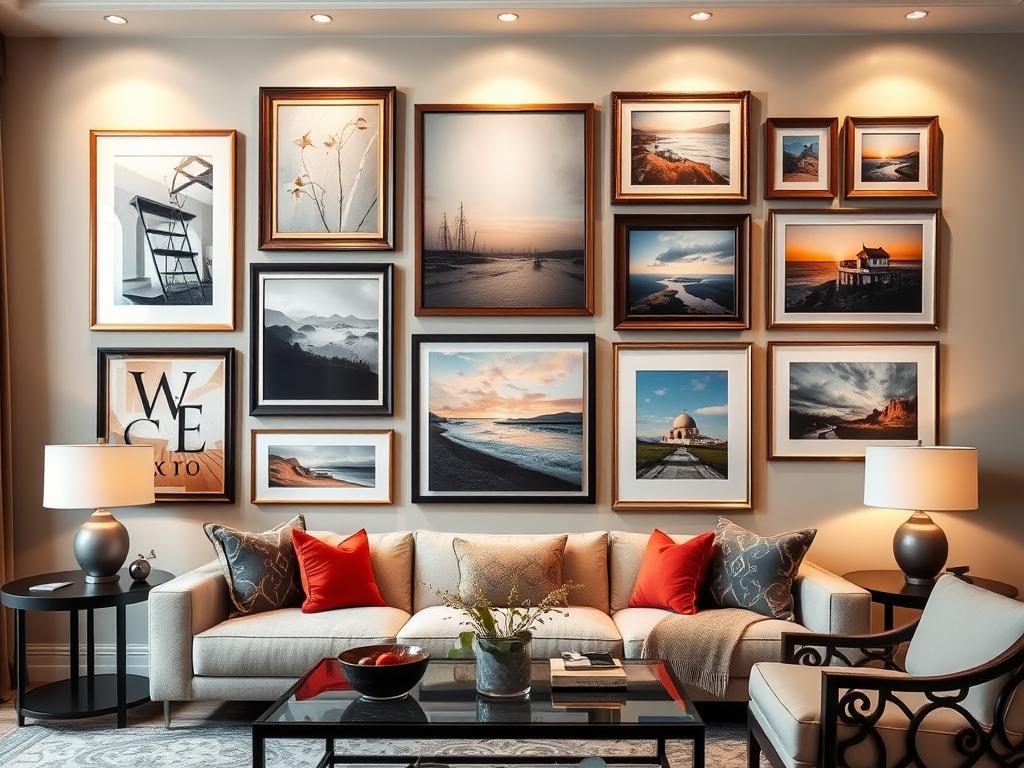
Storage Solutions for a Clutter-Free Space
Keeping your living room organized is key to a clutter-free space. Effective storage solutions boost both function and style. Here are some tips for an organized living room.
Hidden Storage Ideas
Hidden storage keeps your space calm. Look for furniture with hidden spots, like storage ottomans or coffee tables with secret compartments. Built-in shelves also offer hidden storage and keep things tidy.
These ideas are great for small living rooms where space is tight. They help hide clutter, making your room look bigger.
Decorative Storage Options
Choose decorative storage that matches your decor. Stylish baskets, boxes, or benches are both useful and beautiful. They add to your room’s style while keeping it organized.
Minimalist Organization Tips
Minimalism makes your living room peaceful. Only show your favorite items and hide the rest. Use drop baskets to catch clutter throughout the day.
These habits keep your room tidy and open. You’ll enjoy a more relaxed, airy space.
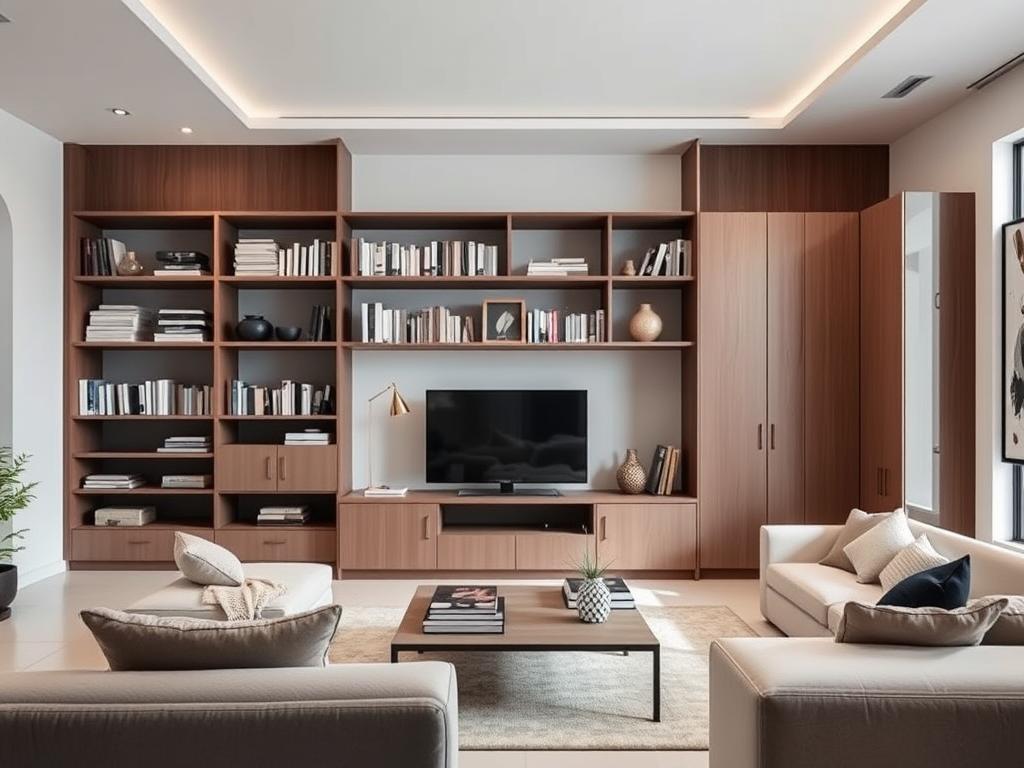
| Storage Solution | Functionality | Aesthetic Appeal |
|---|---|---|
| Storage Ottomans | Hidden storage, extra seating | Integrates stylish design |
| Woven Baskets | Contain clutter | Adds texture and warmth |
| Built-In Shelving | Maximizes vertical space | Creates a tailored look |
| Drop Baskets | Organizes everyday items | Versatile decor accessory |
| Floating Shelves | Displays decor, reduces floor space requirements | Sleek, modern touch |
Bringing Nature Into Your Living Room
Adding biophilic design to your living room can make it feel better. Many homeowners, about 70%, want more natural elements in their homes. This can make your space feel calm and refreshing.
Indoor plants are key to this design. Studies show homes with plants can make people feel up to 40% better. Easy-to-care-for plants like snake plants or peace lilies are great for beginners. They clean the air and make your home healthier.
Natural light is also important. About 80% of people feel happier when their rooms get lots of sunlight. To get more light, think about adding bigger windows or skylights.
Earthy colors and textures also help. Around 60% of people feel more calm in rooms with these features. Using materials like bamboo and reclaimed wood not only looks good but is also better for the planet. Bamboo, for example, is more eco-friendly than regular wood.
In short, using biophilic design in your living room makes it look and feel better. Here’s a quick summary:
| Aspect | Statistics |
|---|---|
| Homeowners desiring natural elements | 70% |
| Impact of natural light on mood | 80% |
| Feeling relaxed with earthy decor | 60% |
| Improvement in well-being with indoor plants | 40% |
| Lower carbon footprint of bamboo | 30% |
| Reduction in stress levels from greenery | 40% |
| Increased air quality with plants | 50% |
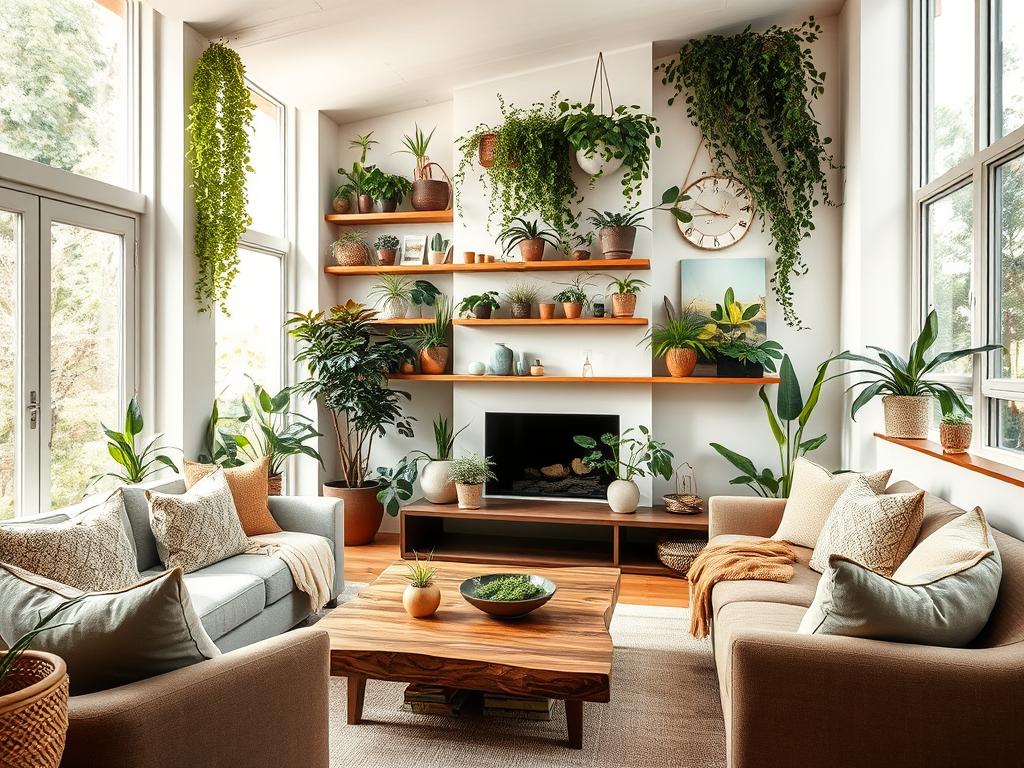
Small Living Room Design Hacks
Designing a small living room is a fun challenge. You don’t have to give up style for function. Use creative furniture, tricks to make it look bigger, and smart multi-functional pieces. This way, you can make your small living room inviting and stylish.
Space-Saving Furniture Choices
Choose furniture that’s compact but practical for small rooms. Sleek sofas add a cozy feel, perfect for autumn. Nesting tables save space when not in use. Low accent tables make your room feel 10% bigger.
Most homeowners, 63%, prefer a cozy space. So, picking smaller sofas is a good choice.
Visual Expansion Techniques
Use tricks to make your room look bigger. Wall-mounted TVs save floor space, about 15%. Mirrors make rooms seem larger and brighter.
Designing your ceiling with wallpaper can make your room feel 15% taller. Horizontal paneling also makes rooms feel wider, reducing the feeling of being cramped by 18%.
Multi-Functional Design Elements
Choose furniture that does more than one thing. Ottomans with removable tops offer storage and extra seating. Fold-out desks save space but are useful when needed.
These smart choices can make your space 30% more efficient. Investing in quality furniture means it lasts longer, up to 20 years. Using consoles with shelves adds storage, a favorite among 45% of small space dwellers.
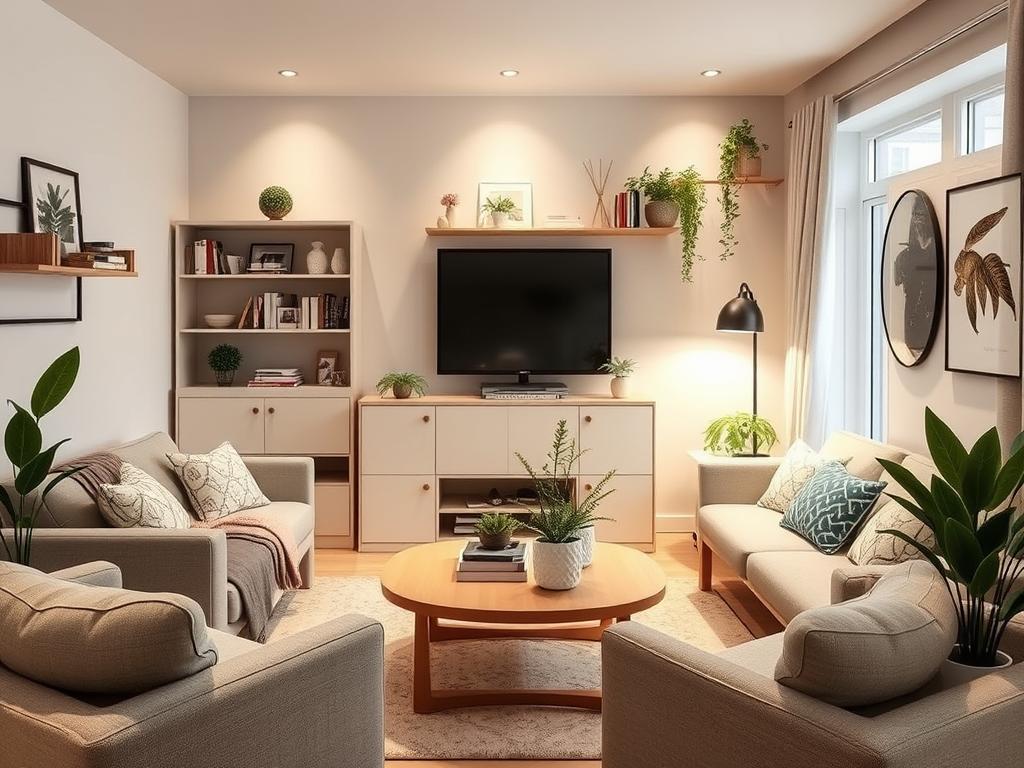
| Design Element | Benefit |
|---|---|
| Wall-mounted TVs | Saves 15% more floor space |
| Nesting tables | Maximizes floor area when needed |
| Low accent tables | Increases perception of space by 10% |
| Ottomans with storage | Increases efficiency in small spaces by 30% |
| Ceiling wallpapering | Enhances perceived room height by 15% |
Transform Your Space Today: Taking Action on Your Design Vision
To make your living room truly special, start taking steps towards your dream design. Modern apps like Decoratly can help a lot. It has a 5/5 rating from over 100 users.
Decoratly lets you add your own touch with colors, furniture, and decor. Begin with small changes for big results. This way, you can slowly but surely change your living room.
Decoratly uses smart tech to help you arrange furniture for the best flow. It works for any room size, from small apartments to big open spaces. You can try out different styles and layouts that fit your life. And it’s affordable, starting at just $4 a day.
Try the free design preview to see how easy it is to plan your room. It keeps your space functional for talking and fun. Use apps to keep your living area fresh and welcoming for everyone.
